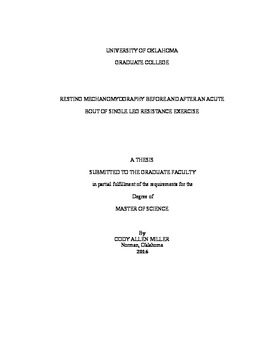| dc.description.abstract | ABSTRACT
RESTING MECHANOMYOGRAPHY BEFORE AND AFTER AN ACUTE BOUT OF SINGLE LEG RESISTANCE TRAINING
Cody Miller
University of Oklahoma
Supervising Professor: Dr. Travis Beck
Mechanomyography (MMG) is the recording of low frequency vibrations along the axis of the axis of the muscle that are detectable at the level of the skin, while electromyography (EMG) detects the electrical action potentials generated by muscles. Previous literature has suggested that resting muscle is inactive due to lack of a resting EMG signal. However, work with sensitive EMG equipment and recent work with MMG during rest has shown resting muscle activity. While the reason for resting muscle activity is largely unknown, it is believed that the activation may have a neural origin. The purpose of the present study is to investigate resting MMG amplitude in the vastus lateralis muscles prior to and following resistance training, and to investigate if a cross-over effect occurs in the non-exercised leg. Ten healthy, college-aged males were measured for resting MMG amplitude 5 minutes before and 30 minutes following an acute bout
of resistance training. The study used two, randomly-ordered visits: a control visit and an exercise visit consisting of an acute bout of resistance training involving six sets of ten repetitions of unilateral leg extensions involving the dominant leg at 65% of their 1 RM max, with 1-min of rest between sets. The results showed no statistically significant differences (p<0.05) between resting MMG amplitude for the exercise versus control visits or for the dominant versus non-dominant vastus lateralis muscles. However, taking into consideration the small sample size, visual inspection, and calculation of effect sizes shows the possibility of a decrease in MMG amplitude in the dominant leg following exercise. This suggests that a relaxation effect may occur following resistance exercise. | en_US |
